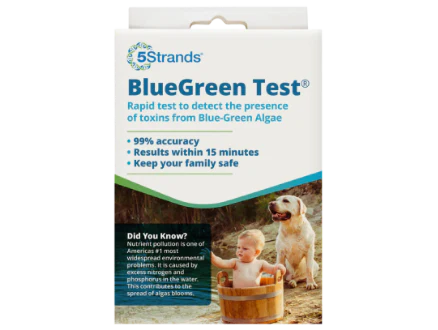By Dr. Ruth Moore
Blue Green Algae and Pets
These three words can strike a pet-owners heart with terror. This phenomenon has been repeatedly written about by the State of Maine, the Portland Department of Parks and Recreation, and the Bangor Daily News in an effort to educate people about the increasing contamination in Maine’s lakes, ponds, and standing water supplies. But the major questions that remain for many people are, what is it, and why is it a threat?
Blue-Green Algae is a cyanobacteria that grows in bodies of fresh, brackish, and saltwater, and it can also appear as yellowish or reddish brown. What makes it different from traditional pond-scum is that it is photosynthetic, and can produce its own food. There are over 2000 varieties of bacteria colonies or blooms that grow every year; with approximately 80 strains being toxic. It is nearly impossible to know which are safe blooms and which are toxic to the untrained eye, and both people and pets are accidentally exposed every year in Maine; thus, people are being encouraged to assume that all forms of Algae growth are dangerous.

How Dangerous IS the Danger?
Blue-green algae can destroy liver function, affect the central nervous system (breathing and circulation), or cause severe skin reactions in animals that are exposed to an algae bloom; with the end result becoming a painful death that occurs within hours if not treated. Should your companion show neurologic signs such as disorientation and seizures or begins to repeatedly scratch after entering (or playing near) a body of water, it may have been exposed; and if untreated, may develop symptoms of shock (panting, drooling) or become lethargic and then comatose.
How Does it Grow?
From the Portland, Maine department of Parks and Recreation, “Cyanobacteria growth is rapidly accelerated by high levels of nitrogen and phosphorus in a body of water. In urban areas, pet waste left behind by pet owners is a leading contributor of nitrogen and phosphorus in the environment.” Likewise, in more rural areas, rain runoff and snow melt can move animal waste into the streams which flow into bodies of water. This contaminated water acts as fertilizer for cyanobacteria, causing blooms when the snow melts and the water temperatures rise.
Are my pets (and family) in danger?
In a word, “yes.” This winter’s weather has been favorable to blue algae blooms growing at an unprecedented rate in the spring. For pet owners, sportsmen, and farmers, this is a very real and present danger to the communities and bodies of water that are nearby. People can mitigate the risks by testing the standing water bodies that their animals can come in contact with. Even if an algae is not visible to the eye, the cyanotoxins can be growing along the shore or in remote areas and then become airborne.
There are three ways for people to test the water.
- The first is the “jar test” that takes up to 48 hours to determine potential blooms, and this test is not 100% reliable.
- The second is to mail a sample to the State of Maine and wait up to a week for results.
- The third and perhaps most expedient / reliable is a new home test developed by 5Strands Affordable Testing. This test is $35, generates results in as little as 15 minutes, and can be purchased online here.

Dr. Ruth recommends that summer enthusiasts keep 3-4 tests on hand and test their water bodies every month over the warmest months to ensure pet safety. It is also a perfect tool for people who travel with pets, to test unknown water bodies at rest stops or vacation destinations. Pets can inadvertently become exposed if they enter the water, or even walk on the edge or walk in pet relief areas that other dogs have walked in.
How can I treat a potential exposure?
Potential exposures must be treated very quickly! Experts advise that you wash both yourself and pet thoroughly within 15 minutes of a known exposure. They encourage the use of a shower and the wearing of gloves to prevent absorbing the toxins through the skin.
They then offer that you monitor the pet for neurological signs of drooling, excess panting, lethargy, or nausea and vomiting. If your pet shows these signs or you develop a headache, nausea, or skin irritation – take your pet to a veterinarian or veterinary emergency room immediately. Your pet has a faster metabolism and does not have the gift of time that humans have for fighting the cyanotoxins.
Spring and summer can be the happiest and funnest months to enjoy with our pets. Dr. Ruth encourages readers to enjoy the weather, take precautions, and have a few testing kits on hand for safety. Next month, she will offer part 2, for human safety.
As she always wishes:
Stay safe, be well, and have fun, because today is a gift that can never be enjoyed again.


























